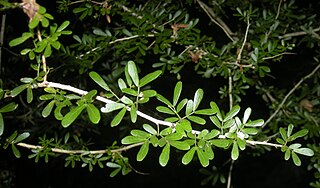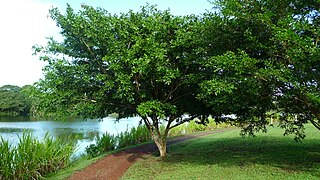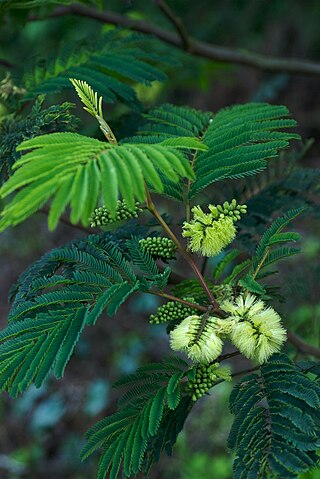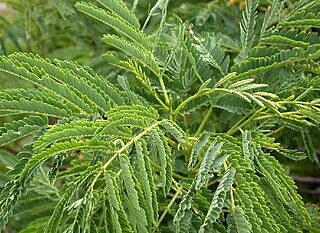
The Mimosoideae are a traditional subfamily of trees, herbs, lianas, and shrubs in the pea family (Fabaceae) that mostly grow in tropical and subtropical climates. They are typically characterized by having radially symmetric flowers, with petals that are twice divided (valvate) in bud and with numerous showy, prominent stamens.

Albizia is a genus of more than 160 species of mostly fast-growing subtropical and tropical trees and shrubs in the subfamily Mimosoideae of the family Fabaceae. The genus is pantropical, occurring in Asia, Africa, Madagascar, America and Australia, but mostly in the Old World tropics. In some locations, some species are considered weeds.

Abarema is a neotropical genus in the family Fabaceae. It is native to Brazil, Cuba, and Venezuela. Most of the species can be found in the Amazon Basin and the Guyana Highlands. They have a deep-green fernlike foliage, with bipinnately compound leaves.
In botany, the correct name according to the International Code of Nomenclature for algae, fungi, and plants (ICN) is the one and only botanical name that is to be used for a particular taxon, when that taxon has a particular circumscription, position and rank. Determining whether a name is correct is a complex procedure. The name must be validly published, a process which is defined in no less than 16 Articles of the ICN. It must also be "legitimate", which imposes some further requirements. If there are two or more legitimate names for the same taxon, then the correct name is the one which has priority, i.e. it was published earliest, although names may be conserved if they have been very widely used. Validly published names other than the correct name are called synonyms. Since taxonomists may disagree as to the circumscription, position or rank of a taxon, there can be more than one correct name for a particular plant. These may also be called synonyms.

Acacia, commonly known as wattles or acacias, is a genus of about 1,084 species of shrubs and trees in the subfamily Mimosoideae of the pea family Fabaceae. Initially, it comprised a group of plant species native to Africa, South America, and Australasia, but is now reserved for species mainly from Australia, with others from New Guinea, Southeast Asia, and the Indian Ocean. The genus name is Neo-Latin, borrowed from the Greek ἀκακία, a term used in antiquity to describe a preparation extracted from Vachellia nilotica, the original type species.

Archidendron is a genus of flowering plants in the pea family, Fabaceae. It includes 98 species which range from India through Indochina, southern China, Taiwan, Malesia, and Papuasia to Queensland and New South Wales.

Archidendropsis is a genus of flowering plants in the family Fabaceae. It includes 11 species, which are native to Australia, New Guinea, the Bismarck Archipelago, Solomon Islands, and New Caledonia.

Zygia is a genus of flowering plants in the family Fabaceae. It includes 60 species of tres and shrubs native to the tropical Americas, from Southern Mexico and Cuba to northern Argentina. Typical habitats are tropical forest and coastal zones, generally below 900 meters elevation with a few species extending up to 2800 meters. It belongs to the mimosoid clade of the subfamily Caesalpinioideae.

Paraserianthes lophantha, the Cape Leeuwin wattle, Bicol wattle, Cape wattle, Crested wattle, Brush wattle or plume albizia, is a fast-growing tree with creamy-yellow, bottlebrush like flowers. It is the sole species in genus Paraserianthes.

Senegalia is a genus of flowering plants in the family Fabaceae. It belongs to the Mimosoid clade. Until 2005, its species were considered members of Acacia. The genus was considered polyphyletic and required further division, with the genera Parasenegalia and Pseudosenegalia accepted soon after.
Pityrocarpa is a genus of flowering plants in the family Fabaceae. It includes seven species of shrubs and small trees native to the tropical Americas, including western and southeastern Mexico, Guatemala and El Salvador, Venezuela and Guyana, Bolivia, and eastern Brazil. Native habitats include tropical coastal rain forest, gallery forest, secondary forest, woodland, wooded grassland (Cerrado), and thorn scrub (Caatinga). It belongs to the mimosoid clade of the subfamily Caesalpinioideae.

Schleinitzia is a genus of flowering plants in the family Fabaceae. It includes four species of trees and shrubs native to the Philippines, New Guinea, and the South Pacific. Typical habitats include tropical secondary rain forest, woodland, wooded grassland, coastal plain, and beaches. It belongs to the mimosoid clade of the subfamily Caesalpinioideae.

Acacia pubescens, also known as the downy wattle, is a species of wattle found in the Sydney Basin in eastern New South Wales. The downy wattle is classified as vulnerable; much of its habitat has vanished with the growth of the city of Sydney. As with all wattles, it has compound (pinnate) leaf stems.

Falcataria falcata, commonly known as the Moluccan albizia, is a species of fast-growing tree in the family Fabaceae. It is native to the Maluku Islands, New Guinea, the Bismarck Archipelago, and the Solomon Islands. It is cultivated for timber throughout South Asian and Southeast Asian countries. This tree is considered to be invasive in Hawaii, American Samoa and several other island nations in the Pacific and Indian Oceans. It reaches about 30 m (100 ft) tall in nature, and has a massive trunk and an open crown.

One of the major human migration events was the maritime settlement of the islands of the Indo-Pacific by the Austronesian peoples, believed to have started from at least 5,500 to 4,000 BP. These migrations were accompanied by a set of domesticated, semi-domesticated, and commensal plants and animals transported via outrigger ships and catamarans that enabled early Austronesians to thrive in the islands of Maritime Southeast Asia, Near Oceania (Melanesia), Remote Oceania, Madagascar, and the Comoros Islands.
Daniel J. Murphy is an Australian botanist.

Heliodendron basalticum is a species of tree native to the dry rainforests of Queensland, Australia.















